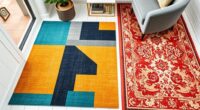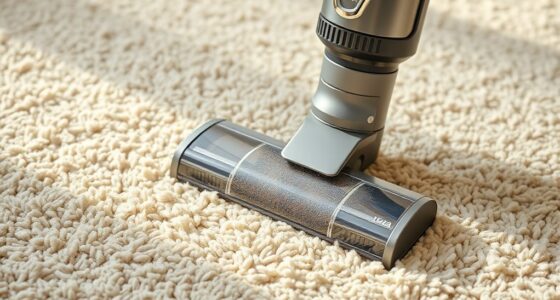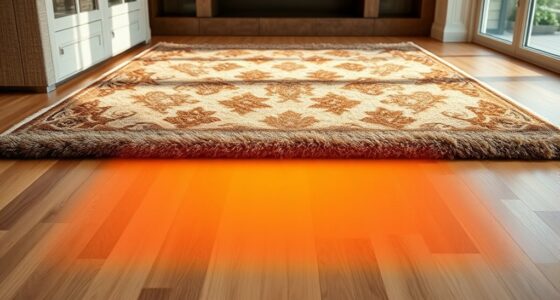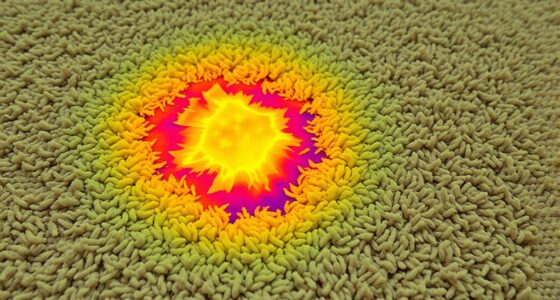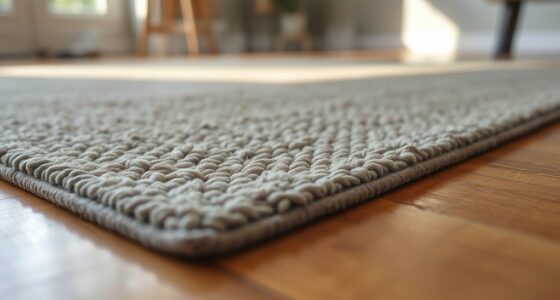When choosing allergy-friendly rug pads, opt for natural fibers like wool, cotton, or jute, which promote airflow and resist mold and dust mites. Avoid synthetic or memory foam options that can trap allergens and release VOCs. Rubber and latex pads can be allergenic or contain chemicals, but untreated natural latex offers antimicrobial benefits. Using anti-allergen coatings and maintaining your rug with regular cleaning can further improve indoor air quality; learn more about making safer choices.
Key Takeaways
- Natural fiber rug pads like wool, cotton, and jute promote airflow and resist mold, reducing allergen buildup.
- Synthetic memory foam and rubber pads can trap dust and pet dander, potentially increasing allergy risks without proper maintenance.
- Latex offers antimicrobial properties but may trigger latex allergies; rubber pads resist mold but can contain irritants.
- Eco-friendly options prioritize non-toxic, breathable materials that minimize chemical emissions and support sustainable practices.
- Regular cleaning, HEPA vacuuming, and choosing washable, hypoallergenic rug pads help maintain allergy-friendly indoor environments.
Natural Fiber Rug Pads

Natural fiber rug pads are an excellent choice for allergy sufferers because they are made from natural, breathable materials that resist dust and mold buildup. Unlike synthetic fibers, which can trap allergens and often require chemical treatments, natural fibers like wool, cotton, and jute promote better air circulation and reduce allergen accumulation. These materials are less likely to harbor dust mites or mold, making them safer for sensitive noses. Additionally, natural fiber pads typically don’t need chemical treatments to enhance durability or stain resistance. This minimizes your exposure to potentially irritating chemicals found in some synthetic options. Choosing natural fiber rug pads can also contribute to sustainable materials use, aligning with environmentally friendly practices. The natural composition of these fibers supports air quality and overall home health. By choosing natural fiber rug pads, you create a healthier environment where allergens are less likely to thrive, helping you breathe easier and enjoy a cleaner space.
Memory Foam and Synthetic Pads

While memory foam and synthetic rug pads are popular for their durability and cushioning, they can pose challenges for allergy sufferers. Synthetic durability means these pads often last longer, resisting wear and tear over time. However, their foam cushioning can trap dust, pet dander, and other allergens within the dense material. This buildup can worsen allergy symptoms if not regularly cleaned. Additionally, some synthetic materials off-gas volatile organic compounds (VOCs), which may irritate sensitive noses and throats. If you choose a memory foam or synthetic pad, look for options labeled as hypoallergenic or designed to resist dust mites. Regular vacuuming and air circulation can help minimize allergen accumulation, but these materials may still be less ideal for allergy-prone individuals compared to natural alternatives. Incorporating air purification devices can further improve indoor air quality and reduce allergen levels. Selecting natural fiber rug pads can be a more allergy-friendly option, as they typically do not trap allergens as much as synthetic materials. Choosing hypoallergenic materials can also help reduce allergen buildup and improve comfort for allergy sufferers. Furthermore, choosing products with certified allergen resistance can offer additional peace of mind for sensitive individuals.
Eco-Friendly and Organic Options
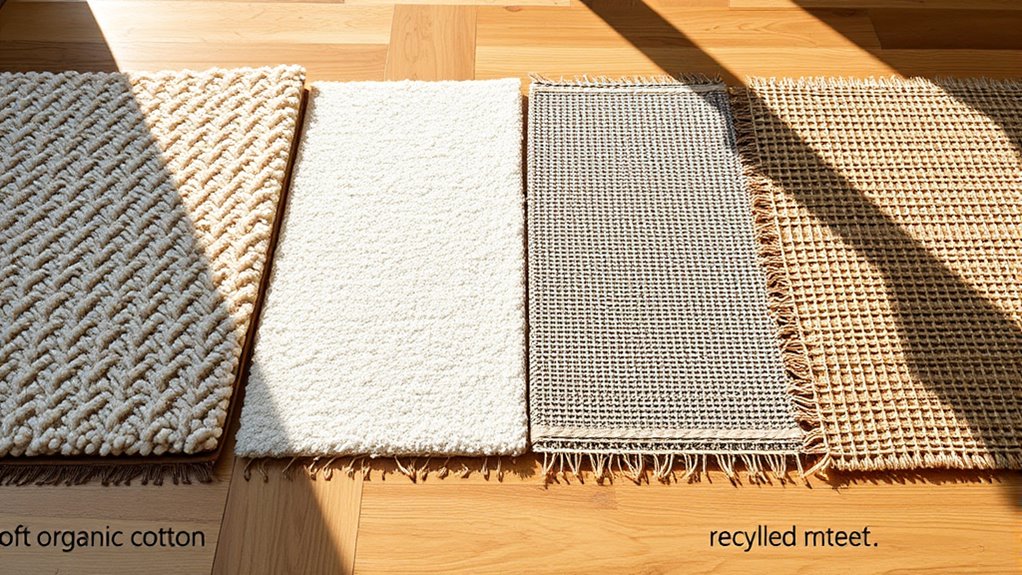
If you’re seeking allergy-friendly rug pad options, eco-friendly and organic choices are excellent because they prioritize non-toxic, breathable materials that resist dust and allergens. These options typically use natural fibers like wool, cotton, or jute, which minimize synthetic scent concerns and reduce chemical emission risks. They also promote better airflow, helping to prevent mold and dust buildup. Additionally, selecting sustainable materials can further reduce environmental impact and enhance health benefits. Using non-toxic materials ensures fewer harmful emissions and contributes to a healthier indoor environment. Incorporating airflow enhancement features can improve ventilation and reduce moisture buildup. While these options may be slightly more expensive or less cushioned than synthetic alternatives, their health benefits outweigh the costs. Choosing eco-friendly and organic rug pads ensures a safer environment for you and reduces exposure to potentially irritating chemicals. Moreover, advancements in AI security are helping to develop smarter safety measures for these environmentally conscious products, ensuring they meet high standards for health and sustainability.
Rubber and Latex-Based Pads
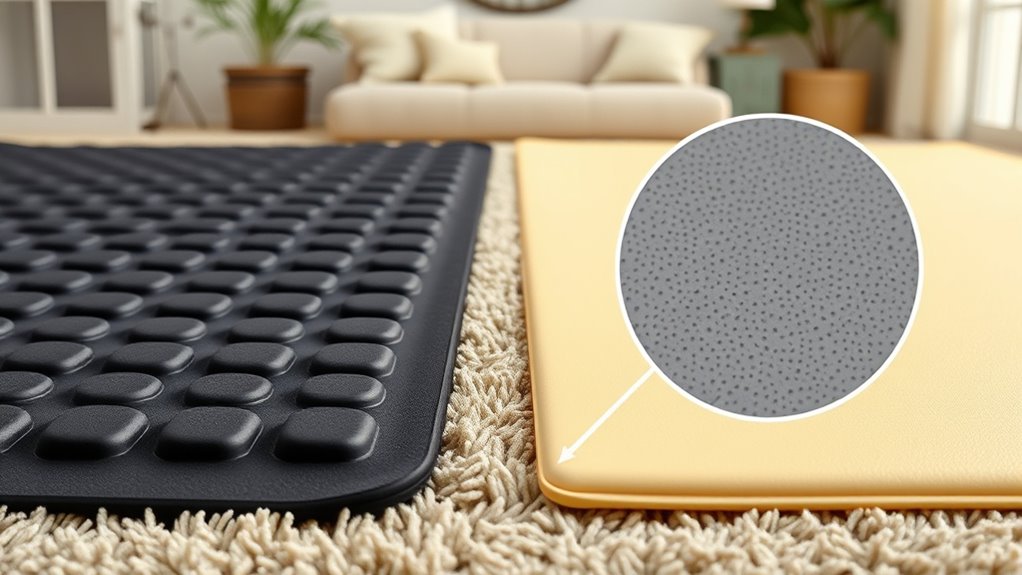
Rubber and latex-based rug pads are common choices, but their material makeup varies considerably. You should consider how their hypoallergenic qualities compare and how each impacts the environment. Understanding these differences helps you select a safer, more eco-conscious option for your home. Additionally, some self-watering planters are made from eco-friendly materials, reflecting a growing trend toward sustainable gardening solutions. To ensure allergy safety, it’s important to examine the material composition of these pads and how they interact with indoor air quality. Evaluating refrigerant management and its environmental impact can also inform your choices for healthier living spaces. Incorporating creative practices into your routine can also help you better recognize and address potential allergens in your living space.
Material Composition Differences
Rubber and latex-based rug pads differ primarily in their material composition, impacting allergy considerations and performance. Rubber pads are typically made from synthetic rubber, which can be treated with fire retardant treatments to meet safety standards. Latex-based pads derive from natural rubber latex, offering inherent antimicrobial properties that help inhibit mold and bacteria growth. These antimicrobial qualities can be beneficial for allergy sufferers, as they reduce allergen buildup. However, some latex pads may contain residual proteins that trigger allergies in sensitive individuals. Conversely, rubber pads are often more chemically processed, which might introduce irritants. Chemical processing can influence both safety and allergenic potential of these materials. Both types can be customized with fire retardant treatments to enhance safety, but understanding their core composition helps you choose a rug pad aligned with your allergy concerns and safety preferences. Additionally, hydrocolloid material used in acne patches illustrates how moisture-retentive substances can promote healing, similar to how certain materials in rug pads can influence durability and allergy potential. Furthermore, ongoing research into hypoallergenic materials is leading to the development of safer, environmentally friendly rug pad options.
Hypoallergenic Properties Comparison
While both rubber and latex-based rug pads offer some hypoallergenic benefits, their effectiveness varies depending on their specific properties. Rubber pads are generally resistant to mold and dust mites, reducing allergy triggers. However, some rubber products may contain chemicals that cause sensitivities in certain individuals. Latex-based pads are naturally resistant to bacteria and mold, which helps minimize allergy risks, but they can also trigger allergic reactions in those with latex sensitivities. Additionally, the potential for chemical emissions from both materials can impact individuals with chemical sensitivities over time.
Environmental Impact Considerations
Considering their production processes and materials, both rubber and latex-based rug pads have notable environmental impacts. Rubber pads often have a higher carbon footprint due to synthetic manufacturing, while natural latex is renewable but still involves resource use. Both materials are not inherently biodegradable, raising concerns about long-term waste. However, biodegradable options exist, reducing environmental harm. To help you understand their impacts, consider this table:
| Material | Carbon Footprint | Biodegradable Options |
|---|---|---|
| Synthetic Rubber | High | No |
| Natural Latex | Moderate | Yes |
| Recycled Rubber | Low | Yes |
| Plant-Based Latex | Low | Yes |
Choosing eco-friendly options minimizes your environmental impact while maintaining allergy friendliness and aligns with sustainable materials principles. Additionally, selecting recycled materials can further decrease environmental damage.
Anti-Allergen Coatings and Treatments
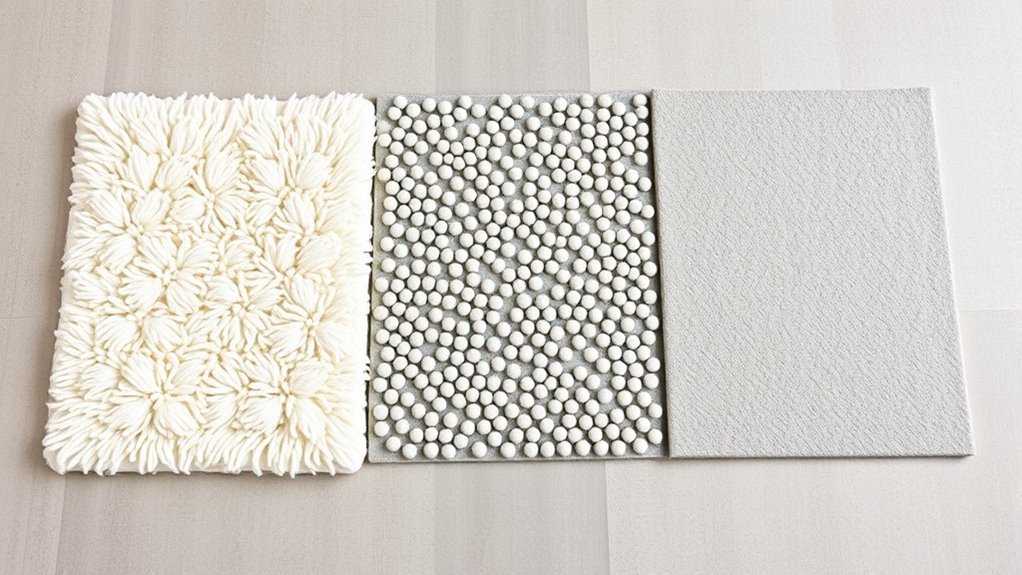
Have you ever wondered if your rug pad could help reduce allergens? Anti-allergen coatings and treatments are designed to minimize allergens like pet dander and mold. These treatments often include antimicrobial coatings that inhibit bacteria and fungi growth, reducing overall allergen presence. Some options feature dander reduction technologies that trap or neutralize pet allergens on contact. When choosing a rug pad with these treatments, look for products that:
- Use antimicrobial coatings for long-lasting allergen control
- Improve air quality by reducing mold and bacteria growth
- Are certified safe for allergy sufferers
- Incorporate safe and eco-friendly materials to ensure non-toxicity and environmental compatibility
Additionally, selecting treatments with proven efficacy can enhance their ability to control allergens effectively. These treatments can substantially improve your indoor environment, making it easier to breathe and reducing allergy symptoms. Always verify that the coatings are non-toxic and environmentally friendly for safe, effective allergy relief.
Tips for Maintaining a Hypoallergenic Rug Area
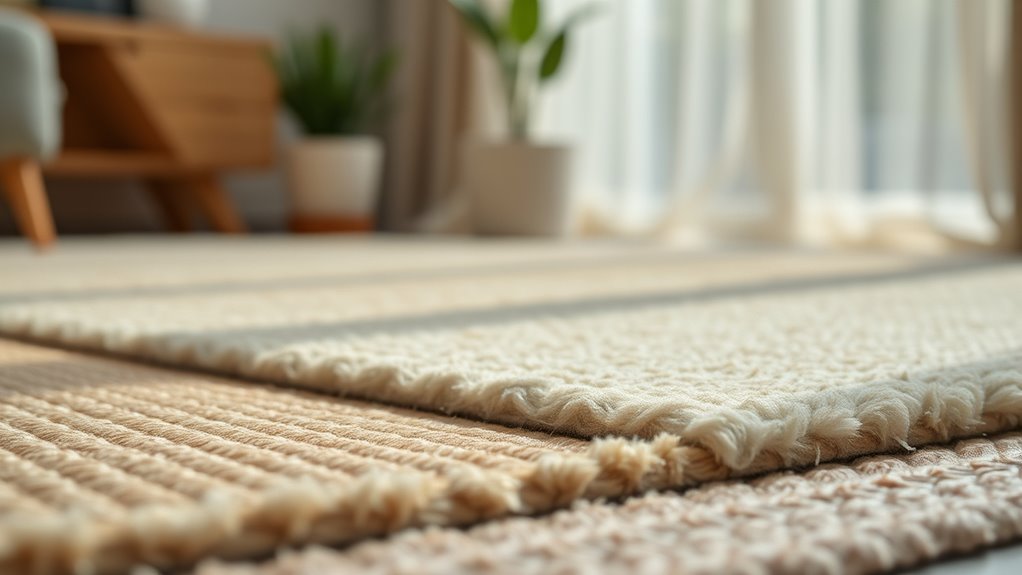
To keep your rug area hypoallergenic, regular vacuuming is essential to remove dust and allergens. Opt for washable rugs whenever possible, so you can easily clean and maintain a fresh space. These simple practices help minimize allergen buildup and keep your environment healthier.
Regular Vacuuming Practices
Regular vacuuming is essential for keeping your hypoallergenic rug area free of dust, pet dander, and other allergens. Consistent vacuuming helps remove pet hair, dirt, and allergens embedded in the fibers, improving air quality. To maximize effectiveness, use a vacuum with a HEPA filter and vacuum slowly to lift debris thoroughly. Incorporate stain prevention techniques, like cleaning spills immediately, to protect your rug’s appearance and longevity. Regularly check and replace vacuum bags or filters to maintain suction power. Additionally, maintain a pet hair removal routine on pets to reduce shedding. Consider using a handheld or upholstery attachment for targeted cleaning around furniture and corners. These practices help create a cleaner, healthier environment in your hypoallergenic rug area.
Choosing Washable Rugs
Choosing washable rugs makes maintaining a hypoallergenic rug area more manageable. When selecting a rug, focus on fabric durability to ensure it withstands frequent washing without tearing or fraying. Durable materials like cotton or microfiber often hold up well and are easy to clean, which helps reduce allergens effectively. Additionally, consider the aesthetic appeal—your rug should complement your space and reflect your personal style. Washable rugs come in various designs, colors, and textures, so you can find one that looks great while remaining practical. Regularly laundering your washable rug removes dust, pet dander, and other allergens, keeping your environment healthier. By choosing a rug that balances durability and aesthetic appeal, you create a comfortable, allergy-friendly space that’s easy to maintain.
Frequently Asked Questions
How Do Allergy-Friendly Rug Pads Compare in Cost?
You’re probably wondering how allergy-friendly rug pads compare in cost. When you do a price comparison, you’ll notice that these pads tend to be slightly more expensive than standard options. However, if you’re on a budget, there are affordable choices that still offer allergy protection. Keep in mind that investing a bit more can provide better materials and durability, making it worthwhile for your health and comfort.
Are There Specific Brands Known for Hypoallergenic Rug Pads?
Oh, you’d think finding hypoallergenic rug pads is a breeze, right? Well, some brands do stand out for their reputation and material certifications, making your search easier. Look for brands known for strict quality standards and eco-friendly materials, like RugPadUSA or Mohawk. These companies prioritize hypoallergenic, non-toxic materials, so you can breathe easier without sacrificing durability or comfort. It’s worth checking their certifications before making a purchase.
How Long Do Allergy-Safe Rug Pads Typically Last?
You might wonder how long allergy-safe rug pads last. Typically, durability testing shows these pads can last between 5 to 10 years, depending on material longevity and usage. High-quality hypoallergenic materials tend to be more durable, resisting wear and tear over time. To maximize lifespan, choose pads made from resilient materials and follow proper care instructions. Regular inspections help guarantee your rug pad maintains its protective qualities longer.
Can Allergy-Friendly Rug Pads Be Used Under All Types of Flooring?
You can use allergy-friendly rug pads under most flooring types, but you should check for flooring compatibility and installation considerations first. Some materials work better on hardwood, tile, or carpet, while others might cause damage or slipping. Always verify with the manufacturer’s guidelines to guarantee the rug pad won’t harm your flooring or reduce safety. Proper installation helps maximize comfort, longevity, and allergy prevention.
Are There Any Health Risks Associated With Synthetic Rug Pads?
You might wonder if synthetic rug pads pose health risks. Synthetic chemical concerns include potential off gassing, which can affect your indoor air quality and cause respiratory issues. Some synthetic materials release volatile organic compounds (VOCs), especially in new pads. To reduce off gassing health risks, choose pads made from low-VOC or natural materials, and guarantee proper ventilation during and after installation. Always check product labels for safety information.
Conclusion
Choosing the right allergy-friendly rug pad can transform your space into a healthier haven. Whether you prefer natural fibers, eco-friendly options, or rubber-based pads, there’s a perfect fit for your needs. Remember, maintaining your rug area regularly can make all the difference—coincidence or not, a clean space often equals fewer allergens. So, select thoughtfully and keep that cozy, allergy-free zone inviting for everyone, including yourself.

